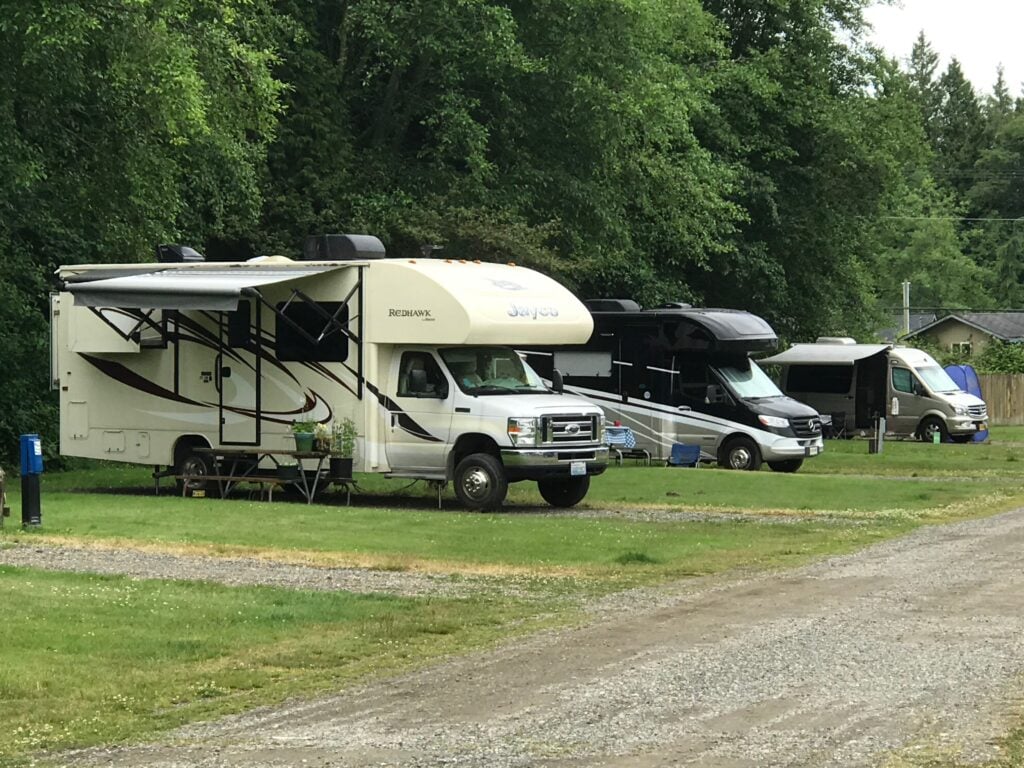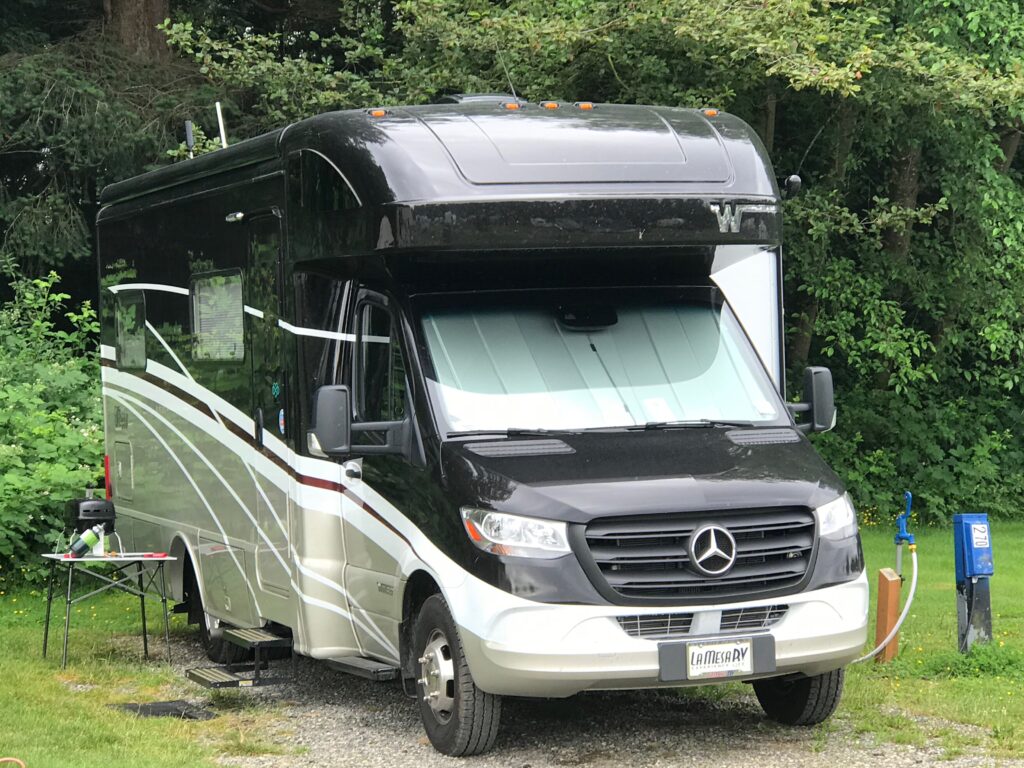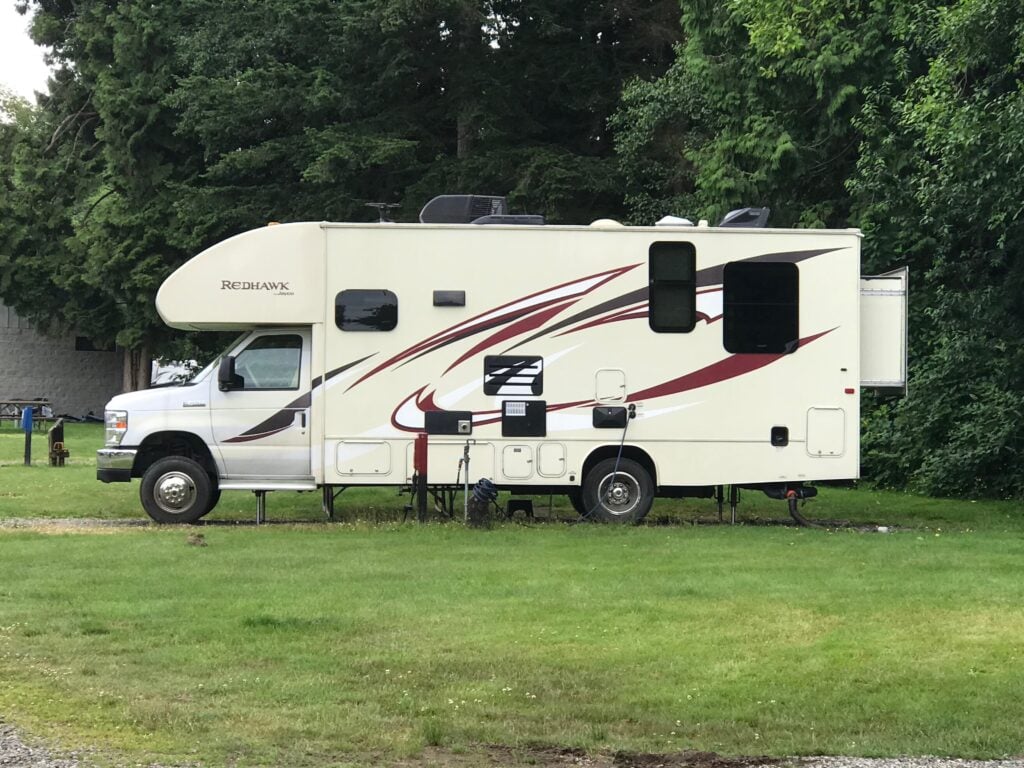
A Class C, B+, and B RV all lined up. How timely. Photo P Dent
Most RV types are easily recognized. No one is confused about the distinctions between fifth wheels, Class As, and travel trailers. But when you get into the Class B RVs, understanding the classifications is a bit more unclear. Keep reading to understand what is a Class B+ RV.
How to Spot Class B+ RVs
A Class B+ motorhome is a hybrid between a Class B and a Class C RV. The difference between a Class B and a Class B+ RV is pretty straightforward. But it is less clear what the distinction is between a Class C and a Class B+ motorhome. Let’s try to make it clearer.
When it comes to a Class B coach, you essentially have a van that has been equipped with most of the amenities of larger RVs. They come with sinks, stoves, refrigerators, holding tanks, toilets, house batteries, beds, sitting areas, and entertainment features.
Class B RVs come with either gas or diesel engines in various lengths and floor plans. One salesperson even stated that some Class B coaches have seating for up to 5 people and there are various combinations of sleeping arrangements for multiple people.
Obviously, storage and tank capacity in these smaller coaches is limited. But what they lack in storage they make up for in their compact agility. Driving a Class B motorhome is very much like driving a minivan or truck. Most of them will fit in the smallest campsites, and they can easily be driven on crowded urban streets.
Camping long-term in a Class B motorhome is certainly possible if you have access to utilities. Or if you are adept at conserving water and tank capacity. Additionally, many of these smaller rigs come with lithium house batteries and solar panels to maximize and extend electrical output.

Class B RV with an outside shower set-up. Photo by P. Dent
The Cost of Class B+ Motorhomes is Not What You’d Expect
If you’re thinking that these rigs may be less expensive because they’re smaller, you will be sadly disappointed. Class B motorhomes have all the luxury features of larger coaches compressed into smaller spaces which creates engineering and construction challenges. In addition to the engineering challenge, many Class B and B+ RVs use more costly higher-end components like lithium batteries in their designs.
The difference between a B and a B+ class motorhome is the chassis weight, the width, and height of the coach, and the addition of one or more slides on the Class B+ motorhome. Like the typical Class B RVs, they can be purchased with either a gas or diesel engine, in various sizes and floor plans. But the B+ is larger in overall size and looks more like a Class C rig.
B+ coaches have an over-the-cab extension much like Class C rigs, but in the B+ this space provides extra storage and entertainment features. The heavier, bigger Class B+ coaches with one or more slides greatly expands the available living space within the RV compared to the Class B RV.
Additionally, the larger B+ RVs carry more fresh water, have more holding tank capacity and larger refrigerators. But like their smaller Class B counterparts, they are agile and compact, fit nicely into most campsites, and are easy to drive and maneuver.
Why RVers Love Luxury Class B and Class B+ RVs
Both styles of RVs, the Class B and Class B+ rigs, are long on luxuries and both styles are very popular RV choices. Certainly, they are not for everyone, but the people who share their rigs and adventures on #ClassBRV on Instagram are enthusiastic about these stylish and nimble campers.
They have most of the features of much larger RVs. These features include: showers, toilets, sinks, and fixed beds. They also have ample storage, refrigerators, air conditioners, flat-screen TVs, stovetop and microwave ovens. Most have bike racks, roof racks, and comfortable swivel bucket seats for both the driver and passenger. All of these typical RV amenities are contained in a much smaller vehicle.
Because of their restricted space, they also have some clever engineering features like laptop tables permanently mounted on swivel-and-stow hardware, and storage bins mounted on the ceiling for electronic tools like laptops, cell phones, notepads, etc.
What about fuel economy?
Don’t forget about fuel economy for Class B+ and Class B motorhomes. You can take all your camping gear with you in a 17-foot to 24-foot light and nimble RV that has amazing fuel efficiency.
Class B and B+ RVs get between 10 and 25 miles per gallon depending on the size, weight, equipment, and driving conditions, but whatever these smaller rigs are able to achieve in terms of fuel efficiency, it’s certainly going to be much better than any larger Class A motorhome.

Is it a Class B+ or Class C RV? What’s going on over the cab, will tell the story. Photo P Dent
The only real difference between Class B+ and C RVs
So, the difference between a Class B and a Class B+ motorhome is fairly obvious. The Class B+ motorhome is bigger, wider, and taller, with an extension over the cab, and with one or more slides. The Class B is clearly smaller and shaped like a traditional van. A Class B RV is longer and taller than a cargo van. But its general shape is still narrow, like a traditional van. Both are wide-body RVs, both have slides, and full bathrooms. They come in either gas or diesel engines. And both have a higher roofline, with an obvious extension over-the-cab.
The only truly unique feature that differentiates these two rigs is what’s happening in the over-the-cab extension. In the Class C RV, that extension is a bunk bed. In the Class B+ rig that extension is used for storage and an entertainment center.

This is a Class C RV with a bed in the over-the-cab extension. Photo by P. Dent
The people who own Class C or B+ RVs don’t buy them just to be seen as an owner of either. They buy the rig that meets their unique needs. If it falls in the category of Class C or Class B+ RV, so be it.
I spoke to the person who owns the Class C shown above and asked her if it was a Class C or B+ and she had no idea. They bought this RV new in 2015, and the class of the RV was an irrelevant detail. What mattered to her was that the form and function of the RV met their particular needs.
I believe that is true for anyone shopping for and trying to understand the difference between a Class B, C, or Class B+ motorhome. When they look at, sit in, imagine camping in, and test-drive these vehicles, the only distinction that will matter is which one feels right, not its class designation.
Is a Class B+ RV right for your needs? Check out our previous article on What Is The Best RV For Your Lifestyle?

Is there a difference in the initial cost of these RV’s? What about resale value; is one more desirable than the other when it comes to selling down the road?
There is another important difference between Class B & Class C motorhomes…….insurance! When we got our latest Class C the agent put it down as a Class B. When we received the policy my wife called & said it was a Class C. The agent apologized & lowered our annual rate by $60. We were told Class Bs typically drive more than Cs so they are rated as higher risks.
Historically A Class C was determined by an approximate 96” wide box and it does not matter if it has a bunk or entertainment center/storage area above cab. Typical B+ is approximately 84” or less.
Class B RV’s are the true “Recreational Vehicles”. Motorhomes which have pull-outs, dual wheels, levelers, are not “RV’s”. When they park they “homestead” and stay. We, in our Class B, are mobile, park anywhere, urban or country, in one night and checking out a day or two later to “Recreate” or recreation with our RV. We can use an RV park as a hub and move out to explore like spokes on a wheel. This is what I had to explain to our Insurance co. that we shouldn’t be rated the same as a Motor Home. We’re a Van on steroids. We are 20 ft long & 15 mpg. Our motto: “Do more with less.”
In my mind, the main difference is a B & B+ is built on a van chassis which may have less weigh carrying capacity and less storage in the under side of the RV. A Class C RV is generally built on a truck chassis which has more weigh carrying capacity and more storage options in compartments on the side and under the floor level which is higher off the ground than on a van body. Getting into a van is one step up while getting into a truck based RV is 2 – 3 steps up because the floor is built on top of the chassis leaving room on the sides to add storage compartments. Storage and weight carrying capacity or as important or more important than a floor plan. Slides ADD weight reducing your weight carrying capacity. Lots of factors to balance.
I appreciate the article. Thanks for coalescing the info.
We had an Explorer 21 ft Class B for years and loved it. When the time came to replace it we bought a Coachman cb20 a 24 ft class C on a Ford Transit chassi. No slides. The additional 3 ft length and 1 ft width allows there to be a full time bed and a real bathroom as well as endless storage. I find it just as easy to drive and maneuver as the B without the living in a tunnel feeling . Had both love the small C.
I own a 2002 class B+ with a smaller, streamlined cab-over that does not extend beyond the windshield as a typical class C does. I have unable to find an rv cover for this shape & size. Should I settle for a class C cover and just tuck in all the excess fabric?
We have a 2020 Winnebago Navion. Winnebago and every other RV motorhome manufacturer’s website shows Mercedes Sprinters with an overcab bed and slides as a “Class C” motorhome. They are all built on a Sprinter van cutaway chassis-cab using exactly the same manufacturing methods as nearly every Class C built on a Ford F53 cutaway chassis-cab with a V-10 or V-8 engine. Everything on the chassis behind the cab is even built on the same assembly line, regardless of whether that chassis is a Mercedes Sprinter, a RAM Promaster, a Ford Transit, or a Ford F-53. And they all have aluminum -framed fiberglass bodies just like nearly every Class A motorcoach out there. So, to an RV manufacturer, every all-steel van body from an auto manufacturer is a Class B camper. Every non-Class A with a fiberglass body is a Class C motorhome.
And, BTW, we just averaged 16.3 MPG in our diesel Navion on a June trip from Alabama to Colorado. With diesel prices often lower than regular gas prices.
The Ford F-53 is a class A motorhome chassis. You’re probably thinking of the E-350 and E-450 cutaway cab and chassis.
There really is no such thing as a B+. All such vehicles are in fact class Cs. All Cs are built on van cutaway chassis, where B’s are not cutways, but are the actual van that has been upfitted with RV related features. Class Cs come in two flavors, those with a bed over the cab, and those without. Someone coined the term B+ to describe those with no bed, but that is not an “official” designation. A more apt designation might be C-, but that has a bit of a negative connotation to it.
All of the images of supposed B+ RVs that shown in the article are in fact Cs and indeed have a bed over the bunk. Without bed, there is no large over cab space. Instead the normal cab profile flows gracefully into the camper body and the small overhead space thus created is then occupied by small cabinets for storage or an entertainment center. I’m not sure why anyone is going out of their way to provide a full description of what a B+ is, since it doesn’t really exist. If it is a van, it is a B, if it is a cutaway, it is a C, end of story.
We own a renegade villagio which is a 24.5’ B+. It is built on a MB sprinter chasis and is diesel and we have storage area with cabinet doors over the cab. It has a slide from behind the drivers door to the rear, which includes the queen sized bed and the dining area. So, for Richard Noll, there is such a thing as a B+. The typical B is a large van with no slides. The B+ vs the C is the over cab bunk area.
Hello Mike,
Because you call your Villagio a B+ doesn’t make it so. Renegade makes the exact same floorplan of Villagio RVs both with a bunk over the cab and without. We are talking identical in every other way here. For example, check out the Villagio 25FWS vs 25FWC. So in this case is the FWS (no bunk) a B+ and the FWC (bunk over cab) a class C? I would argue no – both class Cs.
I two own a similar coach, a Leisure Travel Vans Unity MB. Again no bunk over cab. It is a class C both in my mind (because it is built on a cutaway chassis), and on my title as determined by the DMV. As far as I know, no DMV in the country recognizes anything as a B+. That is just a term that someone came up with to differentiate coaches without a bed over cab from ones with, but is totally unofficial.
Author had a great opportunity to distinguish between B+ and C but did not do it.
Yet another article to add to the confusion of RV Classes. The RVia recognizes 3 types of motorized RV’s: A, B, and C.
The “B+” is a sales term, and the vehicles they refer to, are actually small C’s.
An “A” is built on a devoted truck Chassis.
A “B” is built within the confines of a steel Van, or the manufacturer might add a slide-out, body extensions, or a pop top, but the vehicle started its life as a Van.
A “C” is built ON a Van (or Pick up) “cutaway” or Cab Chassis. The Chassis is shipped to the RV Manufacturer incomplete and they attach the RV “house” portion behind the cab.
Vague mentions of Fuel economy, level of luxury, and even size are not delineators of RV classes.
Thanks Scott. Pretty much what I said, only a bit more concise. Again, the bottom line is there is actually no such thing as a B+.
Richard, well said, you’re absolutely right; B plus motorhomes don’t really exist except in the marketing department of coach manufacturers and dealerships. When you go to register these vehicles they are registered as Class C’s.
The author just confused everyone and didn’t explain the importance of having a unaltered factory built van which has better driving dynamics than a bloated Class C vehicle. Class C’s all have the same thing in common; they are built on a cutaway chassis , and are wider than any Class B. The non metal roof and complete all steel body similar to any other factory built car is not as robust as an all steel body constructed vehicle.
I don’t understand why people still write articles about this “phantom class” unless they are only interested in causing confusion and spreading misinformation.
Class B’s are the fastest growing segment in the RV industry. They are the safest RV’s to drive, get the best fuel economy and have the most mobility of and recreational vehicle. They tend to hold their value more than any other segment. Someone suggested that insurance is higher on a Class B….this is not true.
Good luck Richard and enjoy your travels.